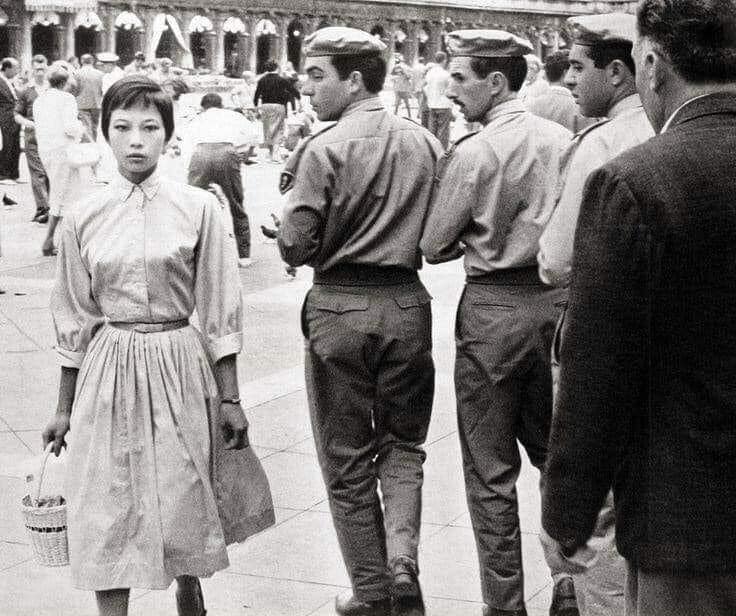 Trinidad-born British actress Jacqui Chan is caught turning the heads of uniformed passers-by in this impromptu photo taken in Venice in 1956 by Antony Armstrong-Jones (later Lord Snowdon), the British socialite photographer who eventually married Queen Elizabeth II's sister. Chan was also a photographic model and, at the time, was Armstrong-Jones's girlfriend. She is thought to have been his first love. Chan had met him in March of 1955, when the 25-year-old photographer took the then-18-year old dancer’s portrait, when she was starring in the play 'Teahouse of the August Moon'. Armstrong-Jones, however, went on to marry Britain’s Princess Margaret in 1960 during the time of his relationship with Chan. When Chan heard the news of her former lover's engagement to the Princess, she reportedly said, "Well, I hope she can cope better than I could." In an interview with The Australian Women's Weekly in February 1961, Chan wanted to make it clear that she had her own success apart from her relationship with Armstrong-Jones. “I do not owe my career to all that sort of publicity," she said. "The suggestion that I had never been offered a job until all this business is what makes me so mad. It just isn't true." Indeed, Chan has had a long and varied career, both as a dancer on stage and an actress on the silver screen. She rose to fame thanks to her turn as Gwennie Lee in a 1959 West End stage production of 'The World of Suzie Wong'. During the 1960s, she had roles in several television series including 'Dixon of Dock Green', 'The Hidden Truth', 'Armchair Theatre', and 'Ghost Squad'. She played the handmaiden Lotus in the 1963 film 'Cleopatra' that starred Elizabeth Taylor. Some of her notable works include the role of Mrs Liu in "Moving Parts" (2017); 'Sherlock' (2012); Mutant Chronicles (2008); Wake of Death (2004); and Netflix drama 'Marco Polo'. Born in 1939, Chan, cousin of famed Trinidadian painter Carlisle Chan, continues to fetch TV and film roles, and has been visiting Trinidad over the years. (Source: Dominic Kalipersad, may 19, 2022)
0 Comments
……….. and they brought in their “jahaji bundles” a culture that reshaped the society of Trinidad and Tobago and contributed to Trinbago’s ethnic mosaic. Jahaji is an Indian word meaning shipmate, specifically those indentured servants who travelled from India to the Caribbean on the same ship. A jahaji bundle was the bundled possessions of some of our ancestors who embarked on a journey one hundred and seventy –seven years ago seeking a better way of life for themselves and their families. The crossing of the perilous dark water or Kala Pani created an unbreakable bond of kinship , the brotherhood of the Jahajis In this brotherhood which blossomed on the Fatal Razak , all barriers of religion, caste and colour were put aside and new relationships flourished , forming a strong bond of kinship among those making the journey to face an uncertain future. Knowing full well of the challenges that awaited them in an alien land and dressed in their dhoti, kurta, sari and laden with their family jewellery, they came bringing with them reminders of their motherland wrapped tightly in their small jahagi bundles. The "jahaji bundle" (four corners of a piece of cloth tied to make a carrier) could be described as a olden-day suitcase that held all the worldly possessions of an indentured immigrant labourer who travelled the high seas for three months to arrive in Trinidad from the port of Howrah in Calcutta in 1845. From food to plants, to seeds, curry and spices and reminders of their religious beliefs they traveled with these in their jahaji bundles. In fact the agricultural landscape of Trinidad has been changed because of the seeds and cuttings of plants which indentured labourers brought in their "jahaji bundles." Despite their heavy sufferings during the indentureship period and years of perseverance, our ancestors have stamped their names on this land. Their legacy lives on. We salute the many contributions our ancestors have made to the development of Trinidad and Tobago. Vintage Photo courtesy Scott Henderson shows two East Indian Indentured servants seated with their jahaji bundle at their feet and a child standing in the shadows of the doorway. (Source: Virtual Museum of TT, May 7, 2022) This is the man for whom Woodford Square is named: Sir Ralph James Woodford, Trinidad’s longest-serving British Governor (1784-1828).
Woodford did much for the development of Port-of-Spain and the island, but he also maintained slavery and discrimination against non-white peoples. He has variously been described as “one of the most progressive Governors” and “a vicious, racist early nineteenth-century leader”. As Governor, Woodford was responsible for rebuilding the square (known as Brunswick Square) and much of the city after the 1808 fire. He improved trade by introducing a round-island steamer service (1818), initiated land reclamation which changed the Port-of-Spain waterfront (1823), and opened primary schools for elite children (1826). He also bought the Paradise Estate and Hollandais Estates (1818), the former becoming the Queen’s Park Savannah, the latter to create a new Government House (now known as President’s House), the Botanical Gardens, and St Ann’s. Both of the current cathedrals in Port-of-Spain have their origins in churches built by Woodford for the Anglican and Roman Catholic communities. Woodford was also opposed to the abolition of slavery and created a system of institutionalised racism. He enforced repressive laws against non-whites, created prescriptions against free black people, and sought to prevent marriages between white and black people. Woodford felt that Trinidad’s free coloureds had too many freedoms, were too rich and too closely ingratiated to white society. He tried to set a legal limit on how much land they could own. He even promoted the segregation of churches, cemeteries too, not wanting whites to mix with blacks even after death. In an article published in Newsday on May 3, 2022, Shabaka Kambon, director, Cross Rhodes Freedom Project, said Woodford was the most notorious racist and white supremacist in T&T’s history. He said, “(Woodford) publicly called on whites in this country to be exceedingly harsh with people of colour, and segregated everything from the pews of the churches to the cemeteries. Blacks and whites were never supposed to be equal or to sit together. “And the work that Woodford did in his reign as the longest-serving colonial governor still affects the people of T&T up to today.” Kambon said Woodford was opposed by Fr Francis de Ridder, the first coloured RC priest in this country, who set up the first desegregated primary school and church, in the time of Woodford. But T&T forgot and ignored him. “The values that he represents we don’t think are worthy to be celebrated publicly. But the man who persecuted him to death, Governor Woodford, the litany of things Woodford did – that man is celebrated over the man who stood up for the values we say we celebrate today.” Sources: •National Trust of T&T https://nationaltrust.tt/contested-heritage-at-the-heart.../ •Caribbean History Archives: http://caribbeanhistoryarchives.blogspot.com/.../picton... •Newsday: https://newsday.co.tt/.../cross-rhodes-freedom-project.../ (Dominic Kalipersad, May 7, 2022) Dr. Fidel Castro paid a visit to Mount St Benedict soon after the Cuban Revolution in 1959. Here he is being greeted by the prior, Dom Hugh van der Sanden. He was accompanied by Ernesto "Che" Guevara, an Argentine Marxist revolutionary, and several members of the new Cuban Regime. Dr. Castro was on his way to Rio de Janeiro. As he was about to leave Piarco International Airport, he looked up into the hills. He beheld the majestic sight of the monastery in the distance and immediately demanded that he be taken there before leaving Trinidad. The hills in the distance reminded him of the hills from which he orchestrated his armed revolt against the authoritarian government of Cuban President Fulgencio Batista. He was warmly greeted by the monks, including Brother Bruno and the prior, who took him for an extensive visit of the monastery.
Dr. Castro who was educated at Havana's Jesuit-run Belen College and who belonged to the Catholic University Students movement while studying law in Havana University, said that Cuba is beginning a new era in which the Christian spirit will prevail. ( Credit Archives from Mount St. Benedict). (Source: Virtual Museum of TT , May 9, 2022) One of the most familiar sights in our country’s religious landscape is the Jhandi or the bamboo pole carrying flags of different colours .
Our East Indian Ancestors of Hindu faith who embarked on our shores 175 years ago brought with them the practice of hoisting and planting triangular flags placed on bamboo near homes and temples after the performance of a pooja (Hindu worship/ prayers ) . The presence of the jhandi is a sign of protection from evil forces and a sign of the devotee's piety. When planted firmly in the ground if symbolizes an upright human being, deeply rooted in spiritual values, filled with devotion and humility and intelligently making life choices that support a God centered life. Once hoisted the flag is never broken or pulled down , the bamboo lasts a very long time and is also known to grow where it is planted. This in itself is a promise to sustain the spiritual life . It would be interesting to know what the different colours mean. (Source: Virtual Museum of T&T, May 4, 2022) — the first group Indians arrived in Jamaica as indentured workers.
By 1917, some 36,000 were on the island. On the plantation, the labourers worked five to six days a week for one shilling a day and lived in squalid conditions. Two shillings and six pence were deducted weekly for their rice, flour, dried fish or goat, peas and seasoning rations. They could only leave the plantation if in possession of a permit. If caught without one or if they failed to work because of ill health or any other reason, they faced fines or imprisonment. The terms of indenture could be one to five, with two weeks annual leave. Labourers could be released from their indenture due to illness, physical disability or in the rare case, manumission or commutation, when they paid the unexpired portion of the contract to their employer. When their indentureships were up, they became known as time-expired Indians and were issued certificates of freedom that enabled them free access to any part of the island. Two years later and no earlier, they could apply for repatriation. If they did not do so they became ineligible even though they could only be repatriated after having lived in Jamaica for 10 years. There was always the option to renew their contracts and become "second-term coolies". Few made that choice. Today there is an estimated 80,000 people of Indian origin living in Jamaica. Indian Arrival Day is annually observed on May 10th. (Source: Dominic Kalipersad, May 10, 2022) Patrick Manning was declared elected unopposed as MP for San Fernando East ahead of the May 24 general election.
He did not have to campaign, owing to a decision of the ACDC-DLP coalition to lead a no-vote campaign. The PNM won the remaining 28 seats on election day, and formed the government with all 36 seats in the House of Representatives. At first, Manning was appointed parliamentary secretary in the Office of the Prime Minister. Then, after the death of Prime Minister Dr Eric Williams in March 1981, he was elevated to a full ministerial portfolio in the Cabinet of George Chambers; holding the Industry and Commerce, and Information portfolios, then Energy and Natural Resources. When the PNM lost the General Election in 1986, Manning was one of three PNM candidates who retained their seats. He became the Leader of the Opposition and within two months was elected to the post of Political Leader of the PNM. In 1991, Manning was appointed Prime Minister. He would again be appointed Prime Minister in 2001, 2002, and 2007. Following the loss of the General Election in 2010, Manning resigned as Political Leader of the PNM but continued as a PNM Representative and Parliamentary Representative for the San Fernando East constituency. When the Parliament was dissolved in 2015, Manning, who was 68 years old, had served in the political arena for 44 years. At the time of his retirement he was the longest serving politician in Trinidad and Tobago. Born in San Fernando in 1946, Manning died on July 2, 2016, from Acute Myeloid Leukemia. (Source: Dominic Kalipersad, May 10, 2022) |
T&T news blogThe intent of this blog is to bring some news from home and other fun items. If you enjoy what you read, please leave us a comment.. Archives
June 2025
Categories
All
|
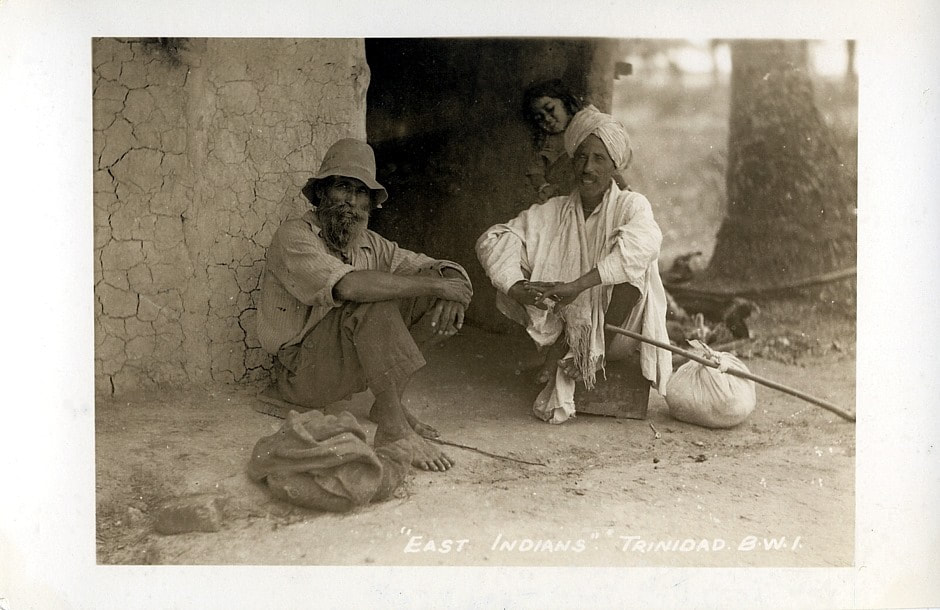
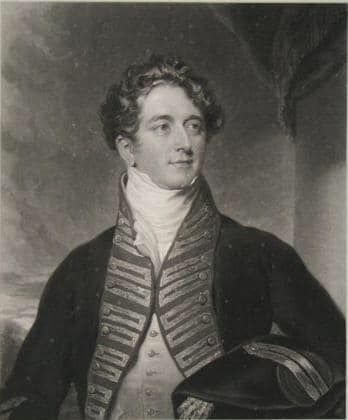
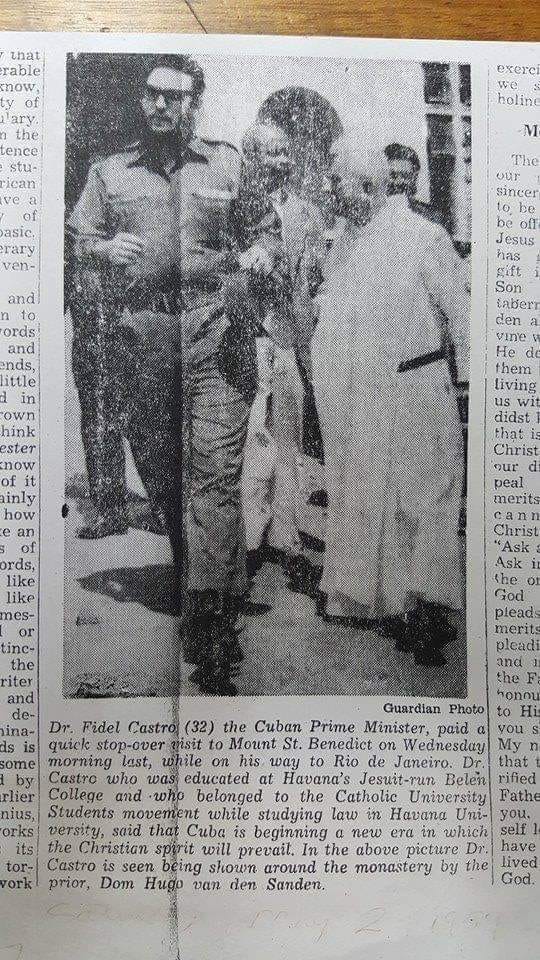
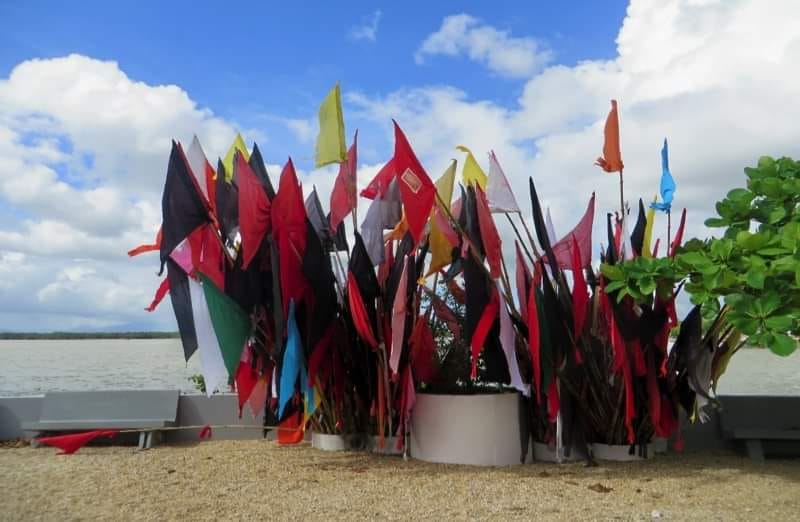
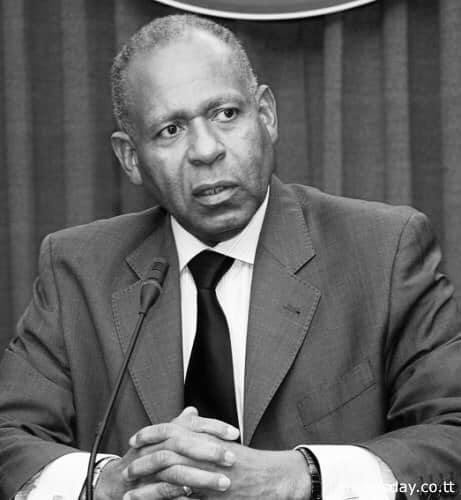

 RSS Feed
RSS Feed